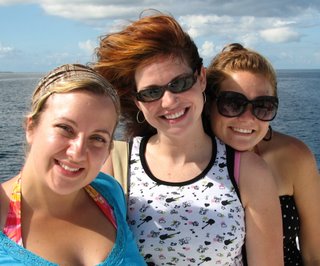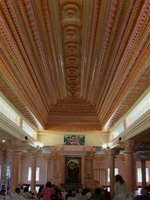Grenada and Carriacou










Grenada and Carriacou
On the first weekend of November, 11 of my classmates and I travelled to Grenada for a fabulous getaway. I know many of you might think that being in Trinidad is like a permanent weekend getaway, but I can assure you it is the furthest thing from anything you might imagine in that sense! Thus, feeling very burnt out from having our lives threatened everyday in Trinidad, we hopped aboard Liat flight 334 from Port of Spain to St. George’s Grenada:
We arrive in Grenada at 9pm local time. Stepping off the plane we expect to face a wall of impermeable and impossibly hot humidity that sticks to you like wet Saran wrap. Much to our delight a gentle gust of warm breeze grazes our tired skin, breathing gentle life to our exhausted spirits, inspiring a second wind. We clear customs quickly and walk outside the airport to establish some bearings. Despite the noticeable stillness and quietness of the soft Grenadian night, we are immediately on guard. The group has a collective sense of mistrust that we extend to all people who appear to be loitering outside the airport, seemingly waiting to take advantage of the walking piggy banks. We stand in a circle with all our baggage in the middle. In typical defensive position that we use when in Trinidad, our backs face the luggage while we watch for signs of danger from all angles. Tension is high.
The hotel transportation arrives for us, and we get inside the taxis. The friendly driver senses our trepidation and guardedness and assures us that we are safe in Grenada and that everything is fine. We should just relax and enjoy ourselves.
Driving along the unlittered, evenly paved road, the melodic chirping of tiny frogs can be heard through the open taxi windows. The frogs are accompanied by the symphonic hum of grasshoppers and the percussive clicking of locusts. The uninterrupted rhythm of the night lulls me into a state of composure –my anxieties lift and I become aware of how much fear and tension I have been carrying around on a daily basis in Trinidad as a necessity of self preservation. Judging by the incredible lightness I now feel, I realize the stress of navigating through the space and place of everyday life in Trinidad.
In an improbable stroke of luck, the Fox Inn proves to be far nicer than the online photos depict. Beautiful, well kept grounds, a deep, clean swimming pool overlooking the beach, friendly staff, fresh rooms, air conditioning! Paradise!
Saturday morning arrives. The air is breezy, and there is still no sign of humidity (very much like Kelowna in the summer). Me, Laura, Tim, and Marla decide to take the ferry to Carriacou (a small island to the North of Grenada). The hotel informed us the night before that the ferry leaves at 9am. Our taxi arrives at 8:30am and tells us that the boat actually leaves at 8:30 on weekends!! He ushers us into the taxi anyways and proceeds to drive like Trinidadian bandits are on his ass, passing cars in the other lane, driving on the curb, flying around hair pin corners like nobody’s business. He frantically phones the fire department (for some reason) to see if the boat is still in the harbour, while honking at oncoming traffic with his “free” hand. Like every multi tasking man, he drives with his knees, navigating the winding mountain roads, risking his life for tourists like he has no other reason to live than to get us to that boat before it leaves. The music is blaring. There is so much adrenaline coursing through my body that I am actually having fun, despite the many pressing barriers to my survival.
He sees the boat sailing in the harbour and swears. Yet, strangely, he begins to drive even faster than before, as if our hastier speed will somehow get us onto the boat. He phones the fire department again. No answer. Finally we pull into the marina, and much to our surprise, the boat is actually still there! We are wind swept and raring to go! The driver is tipped handsomely, and we nimbly hop aboard the dual hulled yacht ready to embark on an exciting day trip!
The time is 8:45am. The 8:30am sailing does not leave the dock until 9:45am. Aha! Caribbean inefficiency does extend to the paradise of Grenada after all!!!!
The Osprey finally pulls away from the dock, its engine roaring to life as it glides out of St. George’s charming bay. European styled buildings crowd the steep hillside while an abandoned British fortress stands at the top of the headland, protecting the lovely town site.
I am sitting on the sundeck of the Osprey. The sky is brilliantly blue and extends seemingly forever to the left, while jagged, rainforest covered mountains pierce the sky to the right. At length we pass the last reach of Grenada and the Osprey is in open sea.
Giant flat bottom clouds punctuate the ostensible infinity of the sky. The sound track is Robert Plant’s Dreamland album. Flocks of flying fish glide for more than 50m on the surface of the sea! They actually flap their fins, I really wasn’t expecting that!
Several hours later, The Osprey reaches Carriacou! It is very small. There are only 7000 people that live on it (about the size of Gabriola Island), and if I had the chance in my life, I would buy a little house on Carriacou! It is just a wonderful place, rugged, beautiful, friendly, not caught up in materialism, yet still very vibrant in its own way. There are packs of wild goats that roam throughout the island like lawn mowing renegades. They dash across the winding roads impishly, and dart into the grassy hills, bleating as their tails twitch awkwardly from side to side. The island is speckled with tiny wooden houses that were at one time painted brightly. The main industry on Carriacou is ship building, a trade that was introduced to the island in the 1700s when a large number of Scottish settlers landed on the white shores. Interestingly, on the far side of Carriacou is a little village called Edinborough; most of the people who live in this area curiously have very fair skin, red hair, and light coloured eyes, yet still have many African features too. It is a surprising combination indeed, and quite curious how the Scottish ancestry remains quite evident in this Patois community even after 300 years.
The marvellous day in Carriacou ends with a flying fish sandwich, an ice cold Carib, and a refreshing swim on the quietest, clearest, calmest beach I have ever had the pleasure of experiencing. What a treat! The boat ride home is a time for reflection as the sun begins its descent across the sky and into the watery deep of the horizon. Nightfall comes quickly as the 4 adventurers step ashore to Grenada. The gentle warm breeze grazes our skin, and we find comfort in the insect symphony that narrates our journey back to the Fox Inn.

















